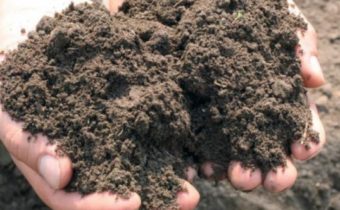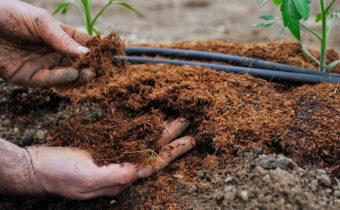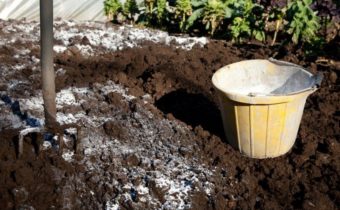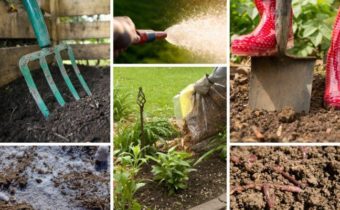How to quickly determine the acidity of the soil
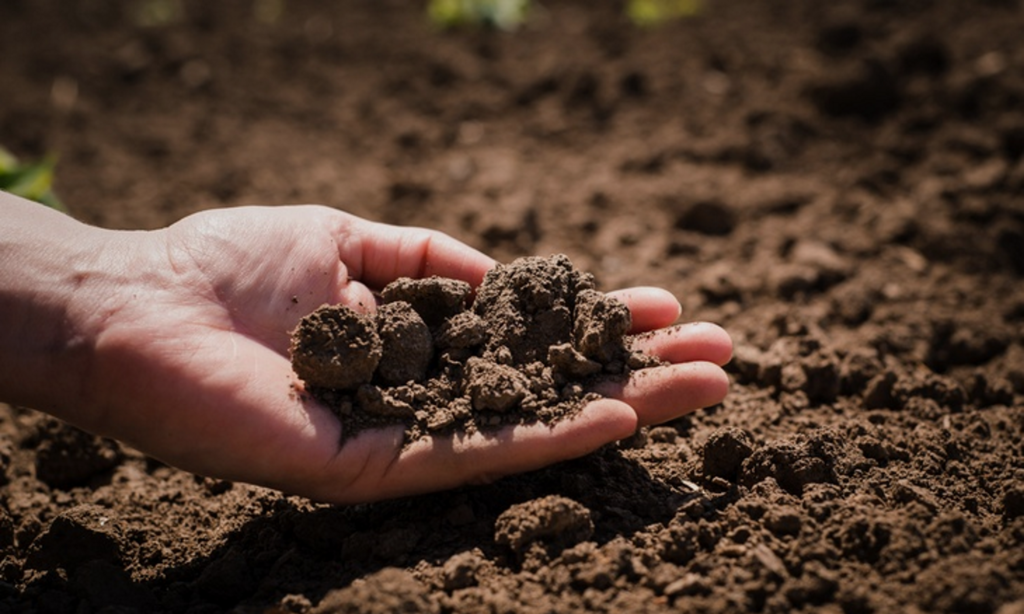
To obtain a rich harvest of any crop, it is important to timely apply the necessary fertilizers and monitor the acid index. A number of cultivated plants are demanding for acidity. The introduction of special substances allows you to adjust the pH and create optimal conditions for growth and fruiting.
What is soil acidity
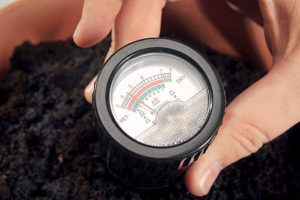
Soil acidity is a chemical indicator that reflects the reaction of soil and rocks. Soil is classified according to acidity as follows.
| Soil character | Acidic | Sour | Subacid | Neutral |
| pH | 4,5 | 4,5-5,0 | 5,0-5,5 | 5,5-7,0 |
If you have the opportunity to carry out chemical analysis in the laboratory, use this. Order also a soil analysis for the content of various elements. Know the acidity of the soil is necessary for the selection of adaptive varieties of crops and measures for the correction of acidity. You can conduct your own analyzes and observations, which will allow you to determine what type of land your garden belongs to.
How soil acidity affects tomatoes
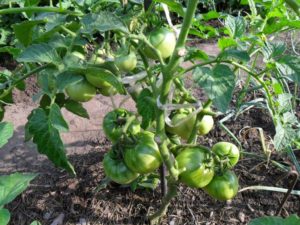
Tomatoes - culture that is fastidious about soil quality and care. The main measures for their care are:
- timely watering;
- loosening;
- feeding
But if you want to get a rich harvest, it should be noted that tomatoes grow superbly and bear fruit on soils with neutral acidity.
It is necessary to ensure that the pH of the soil under the tomatoes is in the range of 5.5 to 6.5.
To determine the type of soil, you should use one of the methods for self-assessment of the soil, or take the land samples to the laboratory.
How to determine the acidity
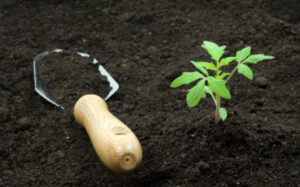
A reliable and reliable method of determining soil acidity is laboratory analysis in a special laboratory. To do this, in a clean container to collect soil. It is advisable to take samples in dry weather. If it is planned to estimate a large area, it is necessary to excavate the land in several places. Tanks are labeled with numbers.
To determine the acidity of his own, there are a number of devices and methods:
- using a special device;
- on fauna growing on the site;
- using chalk;
- using a litmus indicator.
There are also several popular recipes that will help analyze which category the soil belongs to in the tomato cultivation area.
Using a special device
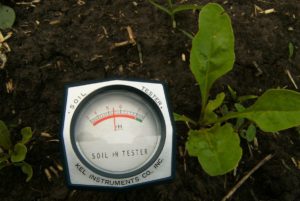
With the development of technology, manufacturers offer to purchase pH meters of various brands that will determine the acidity of the soil in seconds. These are compact devices with a set of various functions. For the test, the pH is immersed in the soil with a special end and indicates acidity to the nearest tenth. Depending on the modification, it can be a scale or a digital scoreboard.
A number of devices has functions of memorization, as well as a built-in hygrometer, with which you can also determine the level of the natural moisture of the soil.
In appearance of the plants on the site
About acidic soils on the site can be concluded from the visual assessment of useful crops that grow in the beds.Plants are deficient in minerals and nutrients, which inevitably affects their appearance.
Pay attention to the ridge with beets. Red streaks on beet leaves signal high acidity. Uniform green coloring of leaves and red scapes speak about neutral ground reaction. Coloring beet tops in red shades means sour soil. Culture itself prefers alkalized medium.
On the beds where garlic, cabbage, onions or beets grow superbly, neutral soil. The rich harvest of radish cucumbers, eggplants, peas, zucchini, potatoes means their growth on slightly acidic soils. Parsley, carrot, and sorrel grow remarkably in acidic areas.
Over weeds

Determining which weeds most often grow in your garden beds, you can conclude about the nature of the soil in the garden:
- thickets of nettle, wheatgrass, burdock, clover, field bindweed, alfalfa show alkaline reactions;
- The bell soil, daisies, horsetail, plantain, horse sorrel, silverweed, wood louse, creeping buttercup, peppermint prefer acid soil.
Areas where weeds of a particular type grow abundantly need to be treated with appropriate fertilizers.
Using chalk
Another way to independently determine the acidity of the soil on the site is the use of chalk. Take the usual school and grind it. Ordinary whitewashing is also suitable without adding any substances to it.

Samples of land about 3 tbsp. l is placed in a transparent glass bottle or jar, pour 5 tablespoons of warm water. l and add crushed chalk 1 tsp. On top of the neck tension on the fingertip or rubber glove. The contents of the jars are mixed by gentle shaking. Filling a volume with a glove or a fingertip means an intense reaction between the ingredients. The release of gas with the mixing of earth, chalk and water means an acid reaction.
Litmus paper
The acidity of the soil is easily determined using a litmus indicator. Specialized stores sell ready-made kits with prepared paper strips, which are impregnated with special reagents.
To determine the indicator of acidity in the kit, a scale is provided, where according to the intensity of the color you can find the color matching of the experienced litmus paper. The set provides several dozen paper elements (usually 50-80) for determining the acidity in the home.
To find out what acidity is the soil in your area, do the following:
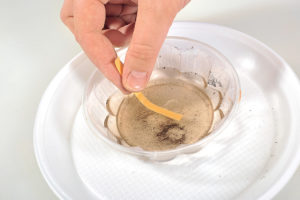
- pick up land in several places;
- make a notch not only from the surface, but also on the recess;
- Take samples in containers and mark;
- take each material and place it in a piece of bandage or gauze;
- Immerse the wrapped soil in a container with distilled water. The volume of water should be 5 times the volume of the earthen sample. That is, if you analyze 1 tbsp. l soil, then the distillate should be at least 5 tbsp. l .;
- leave the sample in the liquid for 5 minutes. This is necessary for the reaction of dissolution of substances in the ground in water;
- Put the litmus test from the kit into the test tank for 2-3 seconds;
- Get the indicator and wait for the reaction in natural conditions.
The litmus test can be colored pink, orange, yellow or greenish.
The method of determining the acidity of the soil is based on the elementary method of carrying out the reaction, familiar to us from school chemistry lessons. Orange color of the indicator means acid reaction, yellow - slightly acid, greenish color - neutral.
On the basis of the results, draw a conclusion, what measures are necessary to carry out in order to achieve the desired acidity. Among gardeners, the “Rottinger” litmus test paper received positive reviews. Indicator products of this brand allows you to conduct the most accurate experiments.
Folk methods and means
In the absence of the possibility to determine the acidity of the soil by laboratory methods, as well as the impossibility of conducting experiments using litmus papers or a special device, use the folk methods:
- visual assessment of soil layers. For the experience, it is necessary to dig a hole 25 cm deep. An ordinary bayonet spade is suitable for this purpose. Examine the fossa walls. If a white layer is present, acidic soils are present in the area being analyzed;
- water assessment in drainage. Find indentations on your site or inspect drainage channels. Rusty water and a rainbow film on the surface of the liquid indicate a strongly acidic reaction;
- using currant leaves or cherries. For personal experience, take 4-5 leaves of a bush and pour 200 ml of boiling water. Wait for cooling. Then dip the ground in the liquid (at least 2 tbsp. L). The color of the infusion will change. Pink color will mean acid reaction, blue - alkaline, greenish - neutral;
- using vinegar essences. Take the usual 70% vinegar and pour it on the ground. Hissing and highlighting whitish haze will show an alkaline reaction. Bubble formation means neutral acidity. The addition of water and a pinch of soda to the vinegar, followed by pouring onto the soil, where foam is formed after absorption, indicates that the soil in this place is acidic.
Simple and affordable reagents that every summer resident has will help determine whether lime is required to be added under tomatoes to reduce acidity or not.
Chemical methods
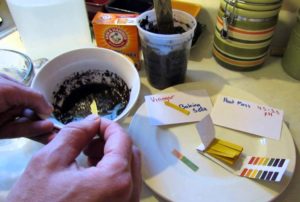
It is possible to independently conduct experiments using self-made litmus indicators. To make them:
- take the leaves of red cabbage;
- chop the leaves or rub on a special grater;
- boil the sliced material in boiling water for 30 minutes;
- cool the contents;
- soak strips of plain white paper in the resulting cabbage broth;
- dry the soaked strips at room temperature.
As a result of the measures taken, you received home-made indicators with the help of which it is possible to determine the soil response in different parts of the territory. To determine the acidity, place the soil in gauze in a container with a small amount of water, leave it for 5 minutes and after taking out, immerse your own cooked litmus paper. Pink coloration indicates acid reaction.
Conclusion
Growing tomatoes and other crops that prefer neutral soils in acidic soil is impractical. The root system of tomatoes is developing poorly. The main leads and roots hardly absorb useful substances and minerals from the soil.
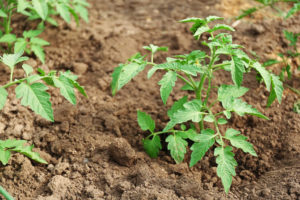
Plants are deficient in nitrogen when growing on acidic soils. In soil with high acidity, the concentration of dissolved iron, manganese and aluminum is increased. There is a shortage of protein. All this together creates unfavorable conditions for the full growth, flowering and fruiting of tomatoes.
To reduce the acidity of the soil should be liming. This procedure is best done in spring or autumn. Lime should be thoroughly crushed. The powder is applied to the ridge with a pre-harvested crop and plucked weeds. Then carry out digging. The soil must be dug to a depth of at least 20 cm. This will ensure lime penetration to depth. Tomatoes and other crops that prefer a neutral soil will thankfully respond with full growth and a rich harvest of juicy and environmentally friendly fruits.


